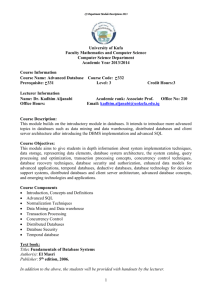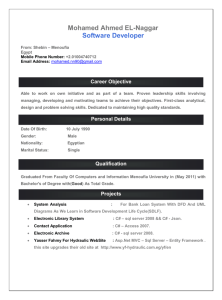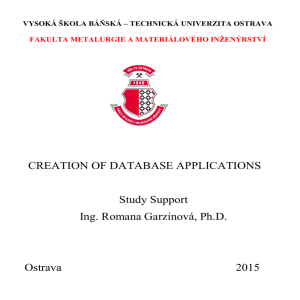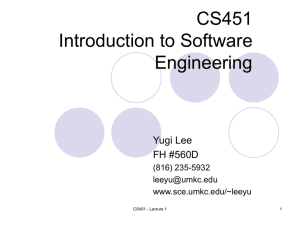Professor: William Shay Office: ES323H Phone: 465
advertisement
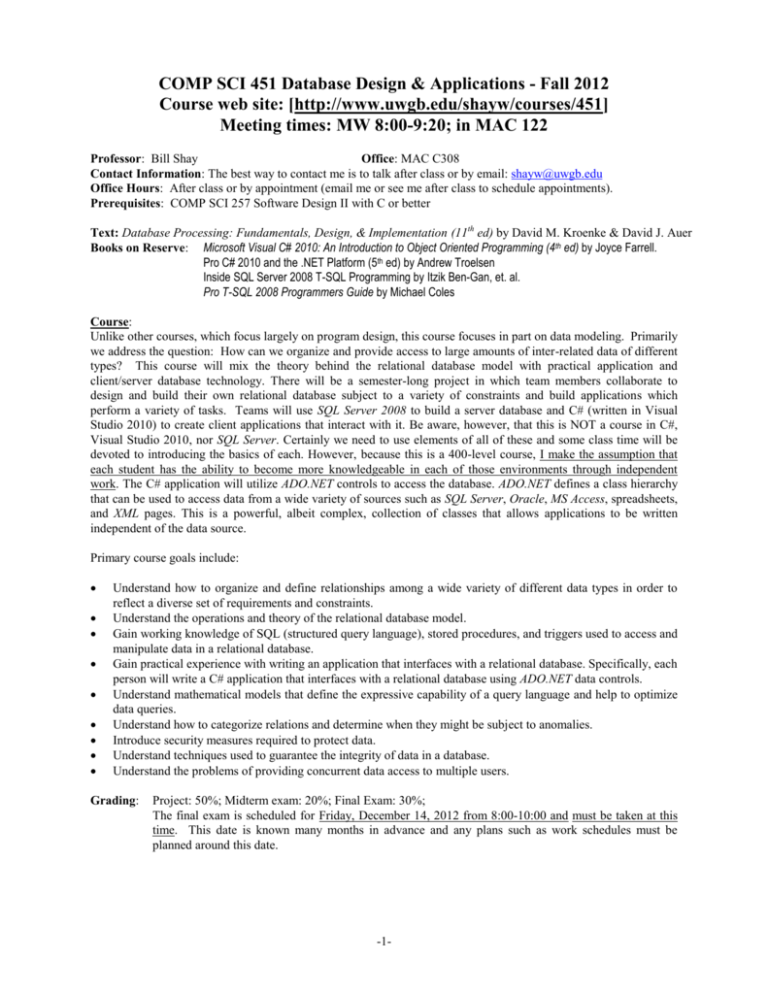
COMP SCI 451 Database Design & Applications - Fall 2012 Course web site: [http://www.uwgb.edu/shayw/courses/451] Meeting times: MW 8:00-9:20; in MAC 122 Professor: Bill Shay Office: MAC C308 Contact Information: The best way to contact me is to talk after class or by email: shayw@uwgb.edu Office Hours: After class or by appointment (email me or see me after class to schedule appointments). Prerequisites: COMP SCI 257 Software Design II with C or better Text: Database Processing: Fundamentals, Design, & Implementation (11th ed) by David M. Kroenke & David J. Auer Books on Reserve: Microsoft Visual C# 2010: An Introduction to Object Oriented Programming (4th ed) by Joyce Farrell. Pro C# 2010 and the .NET Platform (5th ed) by Andrew Troelsen Inside SQL Server 2008 T-SQL Programming by Itzik Ben-Gan, et. al. Pro T-SQL 2008 Programmers Guide by Michael Coles Course: Unlike other courses, which focus largely on program design, this course focuses in part on data modeling. Primarily we address the question: How can we organize and provide access to large amounts of inter-related data of different types? This course will mix the theory behind the relational database model with practical application and client/server database technology. There will be a semester-long project in which team members collaborate to design and build their own relational database subject to a variety of constraints and build applications which perform a variety of tasks. Teams will use SQL Server 2008 to build a server database and C# (written in Visual Studio 2010) to create client applications that interact with it. Be aware, however, that this is NOT a course in C#, Visual Studio 2010, nor SQL Server. Certainly we need to use elements of all of these and some class time will be devoted to introducing the basics of each. However, because this is a 400-level course, I make the assumption that each student has the ability to become more knowledgeable in each of those environments through independent work. The C# application will utilize ADO.NET controls to access the database. ADO.NET defines a class hierarchy that can be used to access data from a wide variety of sources such as SQL Server, Oracle, MS Access, spreadsheets, and XML pages. This is a powerful, albeit complex, collection of classes that allows applications to be written independent of the data source. Primary course goals include: Understand how to organize and define relationships among a wide variety of different data types in order to reflect a diverse set of requirements and constraints. Understand the operations and theory of the relational database model. Gain working knowledge of SQL (structured query language), stored procedures, and triggers used to access and manipulate data in a relational database. Gain practical experience with writing an application that interfaces with a relational database. Specifically, each person will write a C# application that interfaces with a relational database using ADO.NET data controls. Understand mathematical models that define the expressive capability of a query language and help to optimize data queries. Understand how to categorize relations and determine when they might be subject to anomalies. Introduce security measures required to protect data. Understand techniques used to guarantee the integrity of data in a database. Understand the problems of providing concurrent data access to multiple users. Grading: Project: 50%; Midterm exam: 20%; Final Exam: 30%; The final exam is scheduled for Friday, December 14, 2012 from 8:00-10:00 and must be taken at this time. This date is known many months in advance and any plans such as work schedules must be planned around this date. -1- Approximate syllabus: minor changes are possible Week Topics 1 Introduction to databases; overview of storage structures and access methods: linked lists, indexes, B-trees, hash functions. File organizations: Sequential, indexed, and hashed files. Introduction to SQL Server Management Studio and the SQL Server Database Management System. (Chapter 1; first few pages of chapter 10 ; Appendix D (online at http://wps.prenhall.com/bp_kroenke_database_11/127/32761/8386898.cw/index.html); SQL Server databases CS451 Supplier and CS451 Packers). 2-3 Entity-relationship (E/R) modeling: strong and weak entities; attributes; one-to-one, one-to-many, and many-to-many relationships, binary, ternary, and recursive relationships. (Chapter 5). In-class group activity: Project design. 4 Database design: tables, relationships, primary and foreign keys, referential and entity integrity rules, integrity constraints; creating tables from E-R diagrams. (Chapter 6 and 7; SQL Server database CS451 Supplier). 5 Structured Query Language, SQL, queries and subqueries, inner and outer joins; creating and updating views, (Chapters 2, 7, and 8, SQL Server database CS451 Supplier). Also [http://www.sqlcourse.com] and [http:www.sqlcourse2.com]. 6-10 Database access via ActiveX Data Objects (ADO.NET) data controls: connection objects, data adapters, datasets, currency managers; C# applications and controls: forms, listBoxes, datagrids, bindings, buttons, etc.; server-side programming using stored procedures and triggers (sections on stored procedures and triggers from chapter 10; first few sections of Chapter 11; Course demos; reserve books). About midway through this period I will schedule meetings during class time with each group to discuss your progress. There will also be an exam on concepts, design, and SQL. 11 Data normalization: functional dependencies, update anomalies, multivalued dependencies, first through fourth normal forms, non-loss table decompositions (Chapter 3 and 4) 12 Deductive relational databases, rules, logic programming (SQL Server database CS451 Family). 13 Relational algebra, optimization, implementing relational operators (notes), SQL Server query analysis. 14 Multiuser databases: Concurrency control, deadlock, locking, transaction processing, two-way commit, backup and recovery. (Chapter 9). -2-






